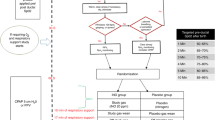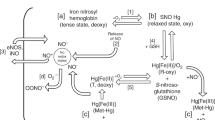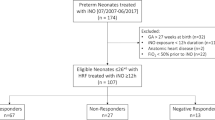Abstract
The blood anion nitrite contributes to hypoxic vasodilation through a heme-based, nitric oxide (NO)–generating reaction with deoxyhemoglobin and potentially other heme proteins1. We hypothesized that this biochemical reaction could be harnessed for the treatment of neonatal pulmonary hypertension, an NO-deficient state characterized by pulmonary vasoconstriction, right-to-left shunt pathophysiology and systemic hypoxemia2. To test this, we delivered inhaled sodium nitrite by aerosol to newborn lambs with hypoxic and normoxic pulmonary hypertension. Inhaled nitrite elicited a rapid and sustained reduction (∼65%) in hypoxia-induced pulmonary hypertension, with a magnitude approaching that of the effects of 20 p.p.m. NO gas inhalation. This reduction was associated with the immediate appearance of NO in expiratory gas. Pulmonary vasodilation elicited by aerosolized nitrite was deoxyhemoglobin- and pH-dependent and was associated with increased blood levels of iron-nitrosyl-hemoglobin. Notably, from a therapeutic standpoint, short-term delivery of nitrite dissolved in saline through nebulization produced selective, sustained pulmonary vasodilation with no clinically significant increase in blood methemoglobin levels. These data support the concept that nitrite is a vasodilator acting through conversion to NO, a process coupled to hemoglobin deoxygenation and protonation, and evince a new, simple and inexpensive potential therapy for neonatal pulmonary hypertension.
This is a preview of subscription content, access via your institution
Access options
Subscribe to this journal
Receive 12 print issues and online access
$209.00 per year
only $17.42 per issue
Buy this article
- Purchase on Springer Link
- Instant access to full article PDF
Prices may be subject to local taxes which are calculated during checkout




Similar content being viewed by others
References
Cosby, K. et al. Nitrite reduction to nitric oxide by deoxyhemoglobin vasodilates the human circulation. Nat. Med. 9, 1498–1505 (2003).
Kinsella, J.P. & Abman, S.H. Inhaled nitric oxide: current and future uses in neonates. Semin. Perinatol. 24, 387–395 (2000).
Clark, R.H. et al. Low-dose nitric oxide therapy for persistent pulmonary hypertension of the newborn. Clinical Inhaled Nitric Oxide Research Group. N. Engl. J. Med. 342, 469–474 (2000).
Roberts, J.D., Jr. et al. Inhaled nitric oxide and persistent pulmonary hypertension of the newborn. The Inhaled Nitric Oxide Study Group. N. Engl. J. Med. 336, 605–610 (1997).
Doyle, M.P., Pickering, R.A., DeWeert, T.M., Hoekstra, J.W. & Pater, D. Kinetics and mechanism of the oxidation of human deoxyhemoglobin by nitrites. J. Biol. Chem. 256, 12393–12398 (1981).
Nagababu, E., Ramasamy, S., Abernethy, D.R. & Rifkind, J.M. Active nitric oxide produced in the red cell under hypoxic conditions by deoxyhemoglobin-mediated nitrite reduction. J. Biol. Chem. 278, 46349–46356 (2003).
Schreiber, M.D. et al. Inhaled nitric oxide in premature infants with the respiratory distress syndrome. N. Engl. J. Med. 349, 2099–2107 (2003).
Inhaled nitric oxide in full-term and nearly full-term infants with hypoxic respiratory failure. The Neonatal Inhaled Nitric Oxide Study Group. N. Engl. J. Med. 336, 597–604 (1997).
Martin, R.J. Nitric oxide for preemies—not so fast. N. Engl. J. Med. 349, 2157–2149 (2003).
Pierce, C.M., Peters, M.J., Cohen, G., Goldman, A.P. & Petros, A.J. Cost of nitric oxide is exorbitant. BMJ 325, 336 (2002).
Subhedar, N.V., Jauhari, P. & Natarajan, R. Cost of inhaled nitric oxide therapy in neonates. Lancet 359, 1781–1782 (2002).
Kinsella, J.P., Griebel, J., Schmidt, J.M. & Abman, S.H. Use of inhaled nitric oxide during interhospital transport of newborns with hypoxemic respiratory failure. Pediatrics 109, 158–161 (2002).
Gladwin, M.T. Haldane, hot dogs, halitosis, and hypoxic vasodilation: the emerging biology of the nitrite anion. J. Clin. Invest. 113, 19–21 (2004).
Furchgott, R.F. & Bhadrakom, S. Reactions of strips of rabbit aorta to epinephrine, isopropylarterenol, sodium nitrite and other drugs. J. Pharmacol. Exp. Ther. 108, 129–143 (1953).
Ignarro, L.J. et al. Mechanism of vascular smooth muscle relaxation by organic nitrates, nitrites, nitroprusside and nitric oxide: evidence for the involvement of S-nitrosothiols as active intermediates. J. Pharmacol. Exp. Ther. 218, 739–749 (1981).
Kimura, H., Mittal, C.K. & Murad, F. Activation of guanylate cyclase from rat liver and other tissues by sodium azide. J. Biol. Chem. 250, 8016–8022 (1975).
Lauer, T. et al. Plasma nitrite rather than nitrate reflects regional endothelial nitric oxide synthase activity but lacks intrinsic vasodilator action. Proc. Natl. Acad. Sci. USA 98, 12814–12819 (2001).
Pawloski, J.R. Hemoglobin and nitric oxide. N. Engl. J. Med. 349, 402–5; author reply 402–405 (2003).
McMahon, T.J. Hemoglobin and nitric oxide. N. Engl. J. Med. 349, 402–405; author reply 402–405 (2003).
Gladwin, M.T. et al. Role of circulating nitrite and S-nitrosohemoglobin in the regulation of regional blood flow in humans. Proc. Natl. Acad. Sci. USA 97, 11482–11487 (2000).
Zweier, J.L., Wang, P., Samouilov, A. & Kuppusamy, P. Enzyme-independent formation of nitric oxide in biological tissues. Nat. Med. 1, 804–809 (1995).
Hunter, C.J. et al. Cerebral blood flow and oxygenation during venoarterial and venovenous extracorporeal membrane oxygenation in the newborn lamb. Pediatr. Crit. Care. Med. in the press (2004).
Coates, A.L., Allen, P.D., MacNeish, C.F., Ho, S.L. & Lands, L.C. Effect of size and disease on estimated deposition of drugs administered using jet nebulization in children with cystic fibrosis. Chest 119, 1123–1130 (2001).
Clay, M.M., Pavia, D., Newman, S.P. & Clarke, S.W. Factors influencing the size distribution of aerosols from jet nebulisers. Thorax 38, 755–759 (1983).
Kinsella, J.P., Neish, S.R., Shaffer, E. & Abman, S.H. Low-dose inhalation nitric oxide in persistent pulmonary hypertension of the newborn. Lancet 340, 819–820 (1992).
Frostell, C., Fratacci, M.D., Wain, J.C., Jones, R. & Zapol, W.M. Inhaled nitric oxide. A selective pulmonary vasodilator reversing hypoxic pulmonary vasoconstriction. Circulation 83, 2038–2047 (1991).
Roberts, J.D., Jr. et al. Inhaled nitric oxide reverses pulmonary vasoconstriction in the hypoxic and acidotic newborn lamb. Circ. Res. 72, 246–254 (1993).
Gladwin, M.T. et al. S-Nitrosohemoglobin is unstable in the reductive erythrocyte environment and lacks O2/NO-linked allosteric function. J. Biol. Chem. 277, 27818–27828 (2002).
Yang, B.K., Vivas, E.X., Reiter, C.D. & Gladwin, M.T. Methodologies for the sensitive and specific measurement of S-nitrosothiols, iron-nitrosyls, and nitrite in biological samples. Free Radic. Res. 37, 1–10 (2003).
Xu, X. et al. Measurements of nitric oxide on the heme iron and beta-93 thiol of human hemoglobin during cycles of oxygenation and deoxygenation. Proc. Natl. Acad. Sci. USA 100, 11303–11308 (2003).
Acknowledgements
The authors thank S. Bragg for expert technical assistance. This work was supported in part by the Clinical Center intramural funds (M.T.G.), and National Institutes of Health grants HL654941 (G.G.P.) and HL58091 (D.B.K.-S.). C.J.H. is a fellow in the Clinical Research Training Program at the National Institutes of Health supported through a grant from Pfizer Pharmaceuticals Group administered by the Foundation for the National Institutes of Health.
Author information
Authors and Affiliations
Corresponding authors
Ethics declarations
Competing interests
The authors declare no competing financial interests.
Rights and permissions
About this article
Cite this article
Hunter, C., Dejam, A., Blood, A. et al. Inhaled nebulized nitrite is a hypoxia-sensitive NO-dependent selective pulmonary vasodilator. Nat Med 10, 1122–1127 (2004). https://doi.org/10.1038/nm1109
Received:
Accepted:
Published:
Issue Date:
DOI: https://doi.org/10.1038/nm1109
This article is cited by
-
The mediterranean way. Should elderly people eat leafy vegetables and beetroot to lower high blood pressure?
Aging Clinical and Experimental Research (2021)
-
Chlorella vulgaris ameliorates sodium nitrite-induced hepatotoxicity in rats
Environmental Science and Pollution Research (2021)
-
Nitrite modulates aminoglycoside tolerance by inhibiting cytochrome heme-copper oxidase in bacteria
Communications Biology (2020)
-
cGMP at the centre of attention: emerging strategies for activating the cardioprotective PKG pathway
Basic Research in Cardiology (2018)
-
Optimization of Single-Step Assay for Circulating Nitrite and Nitrate Ions (NOx) as Risk Factors of Cardiovascular Mortality
Bulletin of Experimental Biology and Medicine (2018)



